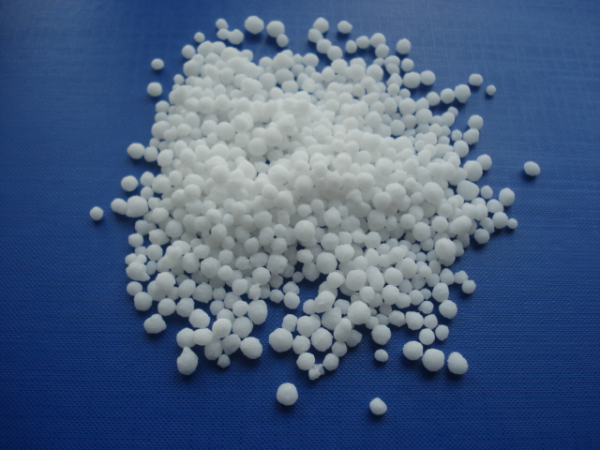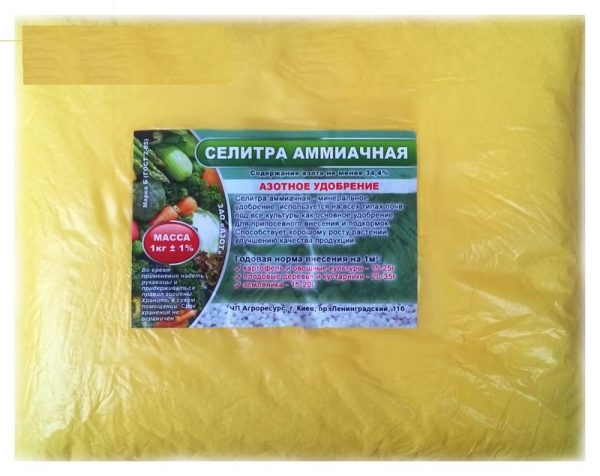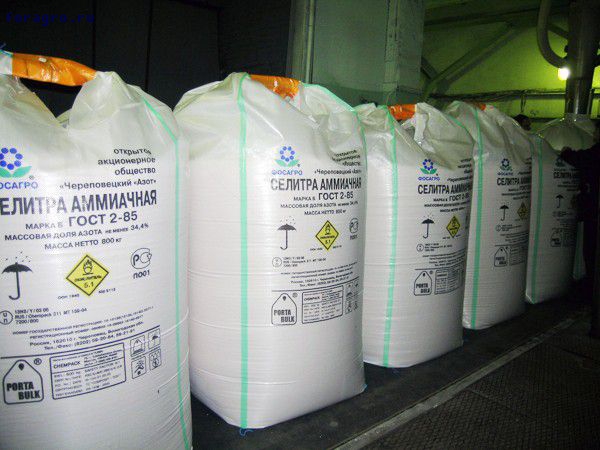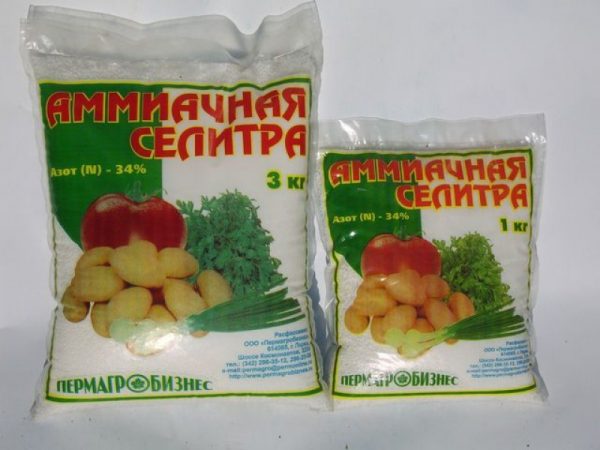Ammonium nitrate as fertilizer: application in the garden
Content
Fertilizers based on nitrate
Saltpeter are salts of nitric acid. They are sodium, potassium and ammonia - it depends on nitrogen compounds. Potassium nitrate contains more potassium (46%) than nitrogen (13%), feeding plants with it activates the processes of photosynthesis. It can be used to fertilize all plants: grass on the lawn, vegetables in the garden, flowers, trees. It is used for root and foliar dressing.
Sodium is also used as a fertilizer, but it was ammonium nitrate with a high nitrogen content that was most widespread. It can feed all types of soil. The use of nitrogen fertilizers has a very good effect on plant growth and crop quality. The low price and the required small amount determine the widespread use of this mineral fertilizer for lawns, trees and vegetables in the garden. In addition to simple ammonium nitrate, grade B ammonium nitrate is also produced. It comes in 2 varieties, is produced in small packages (1 kg), and is used at home for indoor plants or seedlings.
Ammonium-potassium or Indian nitrate is used in the spring, it is an excellent top dressing for fruit trees, it is often fed to tomatoes to improve the taste of the fruit. Calcium-ammonia or Norwegian - contains calcium compounds, potassium and magnesium. It is indicated for any soil, because it does not increase their acidity, but during the production process it is treated with fuel oil, and it does not decompose in the soil for a long time. Calcium supplements are needed for vegetables, but it is better to use another fertilizer. The use of magnesium nitrate is especially useful in the vegetable garden for vegetables and legumes.
Calcium nitrate is produced in a dry, like all other types, and in a liquid state. It is very convenient, it can be used immediately without preliminary preparation.
Video "Using the product for fruit plants"
Informational video about fertilizing fruit plants with the help of the product. Advantages and disadvantages.
Ammonium nitrate
Ammonium nitrate or ammonium nitrate contains from 26 to 34.4% nitrogen and sulfur from 3 to 14%. Plants from the beginning of their growth require a lot of nitrogen, and sulfur helps to assimilate it, this explains its presence in the fertilizer. You can use ammonium nitrate on any soils, but on acidic soils, additional calcium compounds are still required so as not to increase acidity. Ammonium nitrate starts working immediately after application, which is why it is usually used in spring, and this is the only fertilizer that is not afraid of frost. It can only be used for root dressing because it can burn the greens of the plant. This universal nitrogen fertilizer is used for growing flowers, lawns, vegetables in the garden, fruit trees, shrubs. But calcium nitrate can be used for foliar dressing, it can be sprayed with plants.
When applied in spring as fertilizer, ammonium nitrate still protects plants from many diseases, strengthening their immunity.In the garden, the rules of crop rotation are often not observed, repeated crops are planted from year to year, because of this, the top layer of the soil accumulates pathogenic bacteria and fungi. Saltpeter perfectly protects vegetables from them. The same can be said for perennial lawns.
How to fertilize
Saltpeter is produced in hygroscopic granules, it is used simply by adding it to the soil, or it can be diluted with water (according to the instructions) and water the plants carefully so as not to spray the aboveground part. The amount of application depends on the condition of the soil. Usually 20-30 g is enough - per 1 sq. m, and if the soil is very depleted, then 30-50 g is applied - per 1 sq. m. When planting seedlings of pepper, melon, tomatoes, 1 tablespoon without a slide is added to each hole. During the summer, vegetables and trees are still fed. So, in the garden before flowering and after the emergence of ovaries, 5-10 g is applied - per 1 sq. m.
Root crops can be fed in this way: make a groove between the rows and bury 5–7 g per 1 square meter (no deeper than 3 cm). m. One feeding is enough for them 3 weeks after germination. The future lawn and fruit trees are fed with dry ammonium nitrate once in the spring. Trees during the summer can be watered a couple more times with a solution (25 g of nitrogen fertilizers - for 10 liters of water), but it is not recommended to water the lawn - the grass will get burns.Dry ammonium nitrate is buried under trees and bushes in the trunk circle. Its use should always be accompanied by abundant watering - otherwise the granules will not dissolve, which means that nitrogen compounds will not get to the roots. Top dressing is usually carried out in the first half of summer so that the plant does not get carried away by growing stems and leaves to the detriment of fruit formation.
Storage conditions
The hygroscopic granules are sold in plastic or paper bags. Shelf life - 6 months, and after opening the package - no more than 1 month, if improper storage is allowed, the nitrogen will simply evaporate. It must be kept in a dry room, avoiding temperature changes, otherwise there is a risk of the formation of difficult-to-dissolve crystals. Do not mix with other fertilizers. In general, you need to remember that ammonium nitrate is an explosive substance, and you need to handle it accordingly, having carefully studied the instructions. If allowed to heat above 32.3 degrees, an explosion may occur. In summer, storage should be either under a canopy to protect against overheating, or in a cool room.
When using, it is not necessary to apply at the same time as sawdust, manure, straw or peat in order to avoid spontaneous combustion.
Contraindications
Zucchini, cucumbers, pumpkins and squash are recommended to be grown without the use of saltpeter - they can accumulate too much nitrate. Many people are afraid of the word "nitrates", it is associated with chemical fertilizers. Nitrates are nitrogen-containing salts that are found in manure, compost, that is, organic substances that we use as fertilizers. They are necessary for plants for growth and fruiting, it is them in a huge amount that vegetables, fruit trees and bushes are pulled out of the soil. The question is quantity. If you give the vegetables more manure than you need, it will lead to the accumulation of excess nitrates, just like with excess fertilization with nitrate. For this, the norms for the introduction of various dressings are created, they must be observed.
Calcium nitrate is also a nitrate fertilizer. It is better to observe the correct dosage than to deprive the plant of the necessary element. 2 weeks before harvesting, experts advise to stop any feeding, so as not to accumulate excess salts in the fruits.
Video "How to make top dressing"
Video instruction on how to make fertilizing for watering plants.





